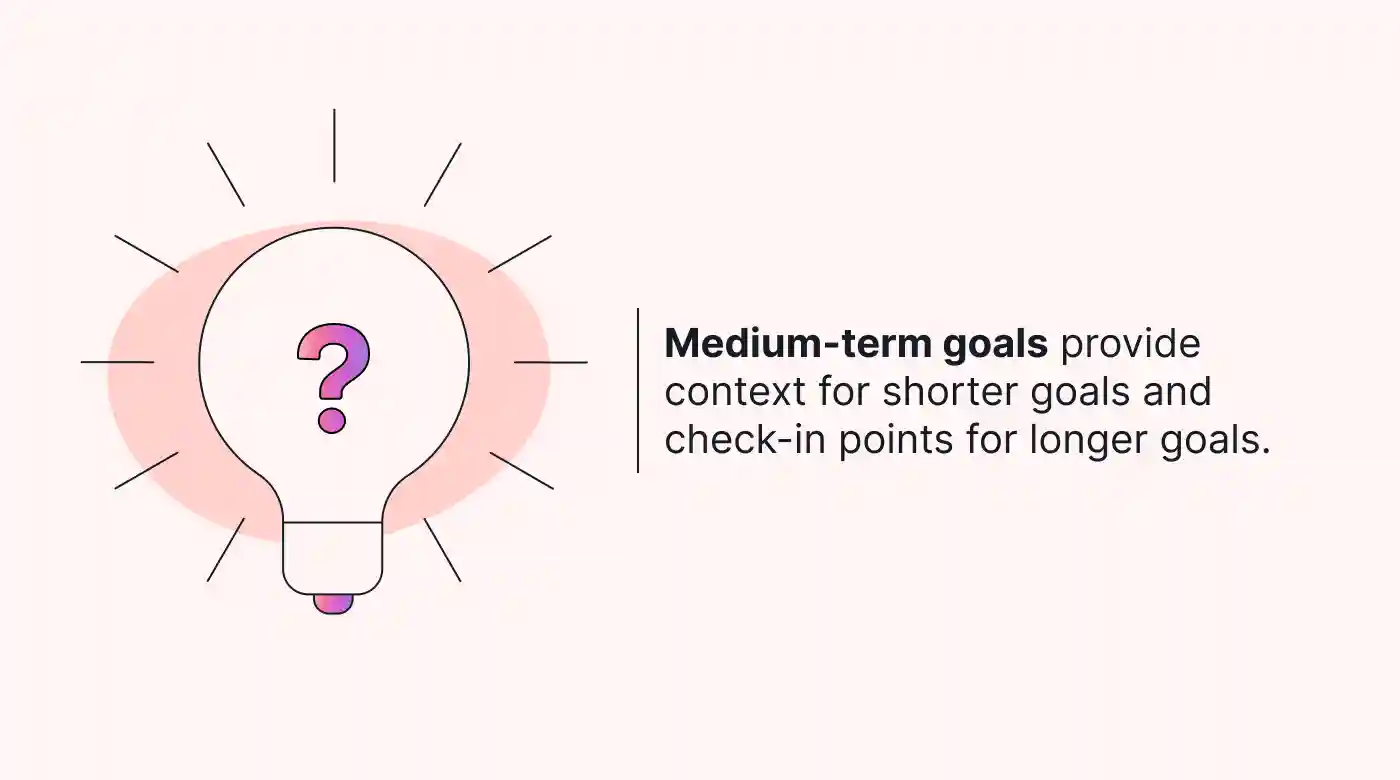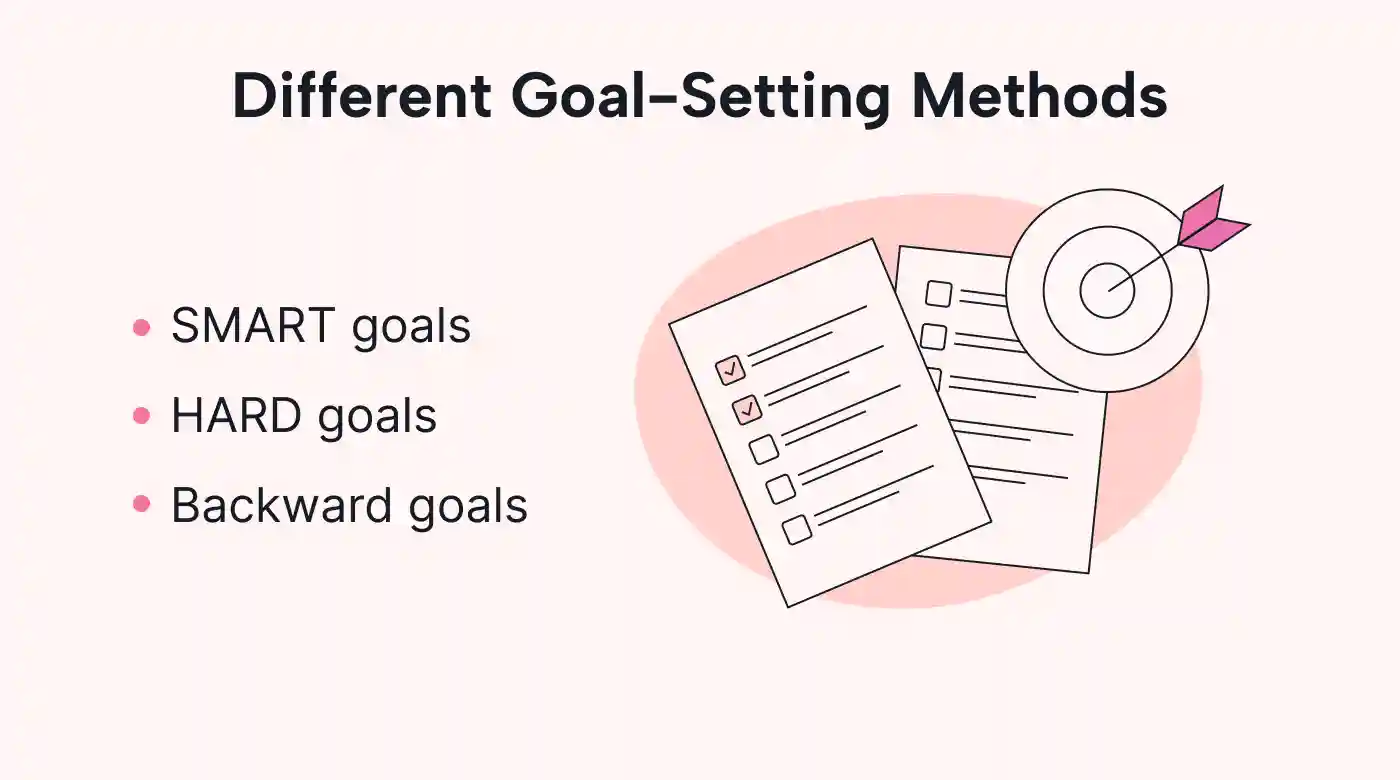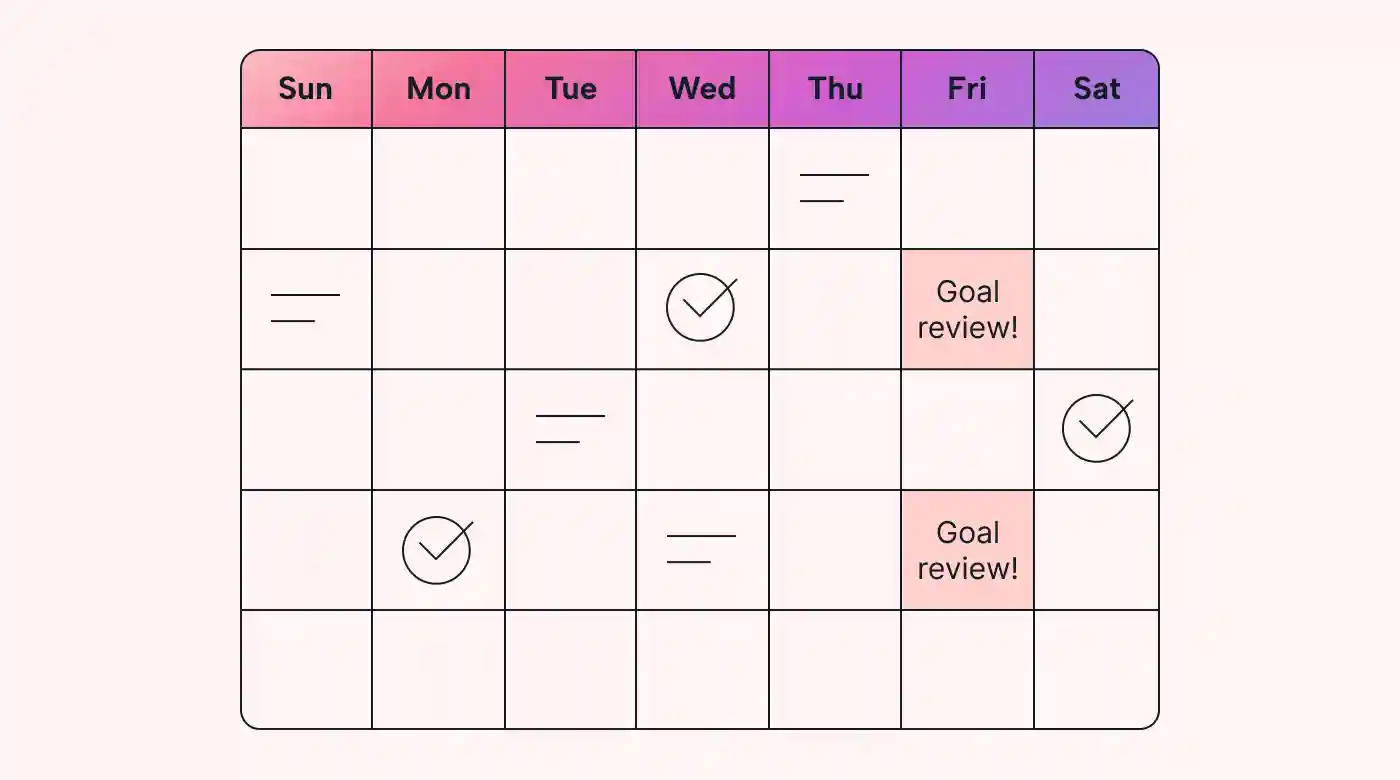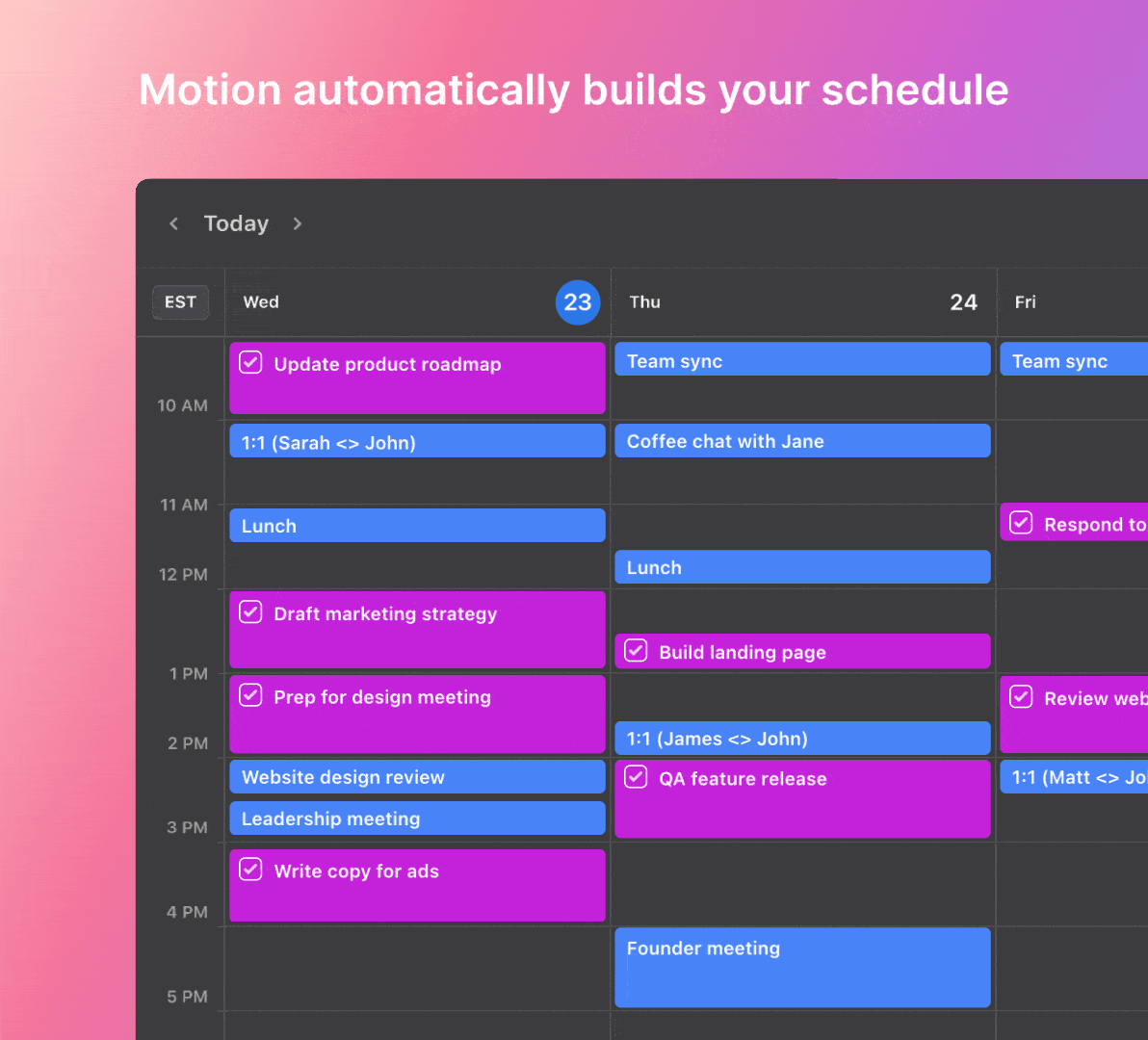Everyone has big dreams. That’s because dreaming big is the easy part.
The challenge is filling in all the steps that bring you to your lofty goals.
Many working professionals find themselves stuck between the monotony of daily life and the impossibility of their long-term goals, with no way to bridge the gap between the two.
Medium-term goals are the missing link between lifelong dreams and daily tasks. Falling somewhere on the one- to five-year scale, these goals help you stay on the right track as you move toward lasting success.
In this article, we explore the value of medium-term goals, discuss how to set effective and actionable medium-term goals, and give you 25 examples of medium-term goals to inspire you.
What are medium-term goals?
Medium-term goals are goals you can achieve in one to five years and build toward your life vision. In general, you should have between three and seven medium-term goals within each area of your life, including your career, life skills, personal finances, education, and fitness.
 |
How do medium-term goals compare to short-term goals?
Typically, short-term goals are achievable in less than a year. They direct your day-to-day actions and put you on the path toward your medium-term goals.
In contrast, medium-term goals provide context for your short-term goals. Completing a single task in isolation might seem like a waste of time. But when you look at that task in the context of your medium-term goals, you’ll understand why it’s necessary.
How do medium-term goals compare to long-term goals?
Long-term goals are achievable in 10 or more years. They drive your direction and strategy.
Your medium-term goals build up toward your long-term goals. Tracking them gives you a progress bar toward the goals you’d like to achieve down the road.
Why are medium-term goals important?
If you have short-term and long-term goals, are medium-term goals even necessary?
Definitely.
Medium-term goals serve the following functions:
- They provide the motivation behind your short-term goals and connect them to the bigger picture.
- They provide check-in points for you to track your progress as you work toward your long-term goals.
- They give you opportunities to reevaluate your long-term goals and see if you still want to achieve them, if they’re still realistic, and if your timeline makes sense.
- They help you maintain momentum and motivation as you move toward your long-term goals.
How to set effective medium-term goals
Many working professionals approach medium-term goals haphazardly. This disorganization often stems from the fact that medium-term goals don’t feel as important as long-term goals and require much more planning than short-term goals.
This means medium-term goals are at risk of falling off your radar — that is unless you do the following:
Consider different goal-setting methods
Knowing how to set effective goals is the first stage in achieving them. The following goal-setting methods can help you translate your big dreams into manageable steps:
 |
SMART goals
Standing for Specific, Measurable, Achievable, Relevant, and Time-bound, SMART goals make your theoretical ideas actionable by forcing you to work out the specifics of each goal right at the start. These factors keep you accountable and on track.
SMART goals can be set for various periods. Once you’ve defined the timeline for your medium-term goals, you can set SMART short-term goals to keep you on track.
HARD goals
Standing for Heartfelt, Animated, Required, and Difficult, HARD goals are great for increasing your engagement and motivation because they link your goals to something bigger than yourself.
The HARD goals method is less detailed and structured than other goal-setting techniques, but it can be incredibly useful for those motivated by empathy and passion.
Backward goals
Imagine having a desired endpoint and working retrogressively to build a game plan for achieving that goal. You can divide your steps into as many short, medium, or long stages as you need.
This is the backward goal-setting method.
The backward method helps you turn big dreams into actionable steps without making the process feel overwhelming.
Create medium-term goals you can reach
If a specific goal-setting method isn’t working for you, try to keep the following pointers in mind:
- Be as specific as possible. Vague goals are difficult to put into action because your goalposts can shift without clear, hard insight into what you’re working toward. And without specifying the results you’re aiming for, it’s very hard to track and monitor your progress.
- Know your “why.” Your “why” refers to the reason you’re aiming for a specific goal. Keeping it in mind helps you progress even on days when you feel uninterested and discouraged.
- Schedule goal reevaluations. Sometimes, achieving a goal takes much longer than you originally expected it would. Proactively scheduling goal reevaluation sessions gives you a chance to work around delays in progress and adjust your plans accordingly.
- Know the metrics you’re measuring your goals with, and use them to evaluate your progress throughout the years. During your reevaluation sessions, review your progress and timeline and update them as needed.
 |
- Review your goals often. Writing your goals down and reading through the list once every month or two helps keep them at the forefront of your mind.
- Remain flexible. Medium-term goals are harder to set in stone than short-term goals because a lot can change in a year or two. Give yourself the grace to change your plans and adjust your goals as necessary.
If you find yourself losing interest in a goal, disconnecting from your “why,” or dreading the tasks needed to meet a goal, then it might be time to change tracks.
Avoid common mistakes when setting medium-term goals
The three most common mistakes people make when creating medium-term goals are being too vague, misdirecting their attention, and mistaking a long-term goal for a medium-term one.
Let’s take a look at each of these.
Mistake #1: Being vague
“I will increase my profits.”
This is a great goal in theory, but it’s missing all the information that makes the goal actionable.
A better goal would be: I aim to increase my net profits by X% in [amount of time]. I will do this by reducing overhead costs [this way] and selling [new product].
Mistake #2: Misdirecting your attention
“I will earn more money.”
With a goal like this, your focus is on the secondary result of achieving some other goal. Instead, focus your attention on the goal that results in increasing your earnings.
A better goal would be: I want to increase my earnings by X%. I will work toward [promotion/raise] by meeting all my deadlines, building strong client relationships, and approaching my boss on [date] to discuss options.
Mistake #3: Fitting long-term goals into medium time frames
“I will become CEO in three years.”
If you’ve just finished your first internship, then this goal is likely unachievable in the time frame you’ve set.
A better goal would be: I will work toward becoming [promotion] in [time frame] to continue toward my long-term goal of becoming CEO in 10 years’ time.
25 examples of medium-term goals
Whether they’re personal or professional, medium-term goals are powerful tools that can help you create a life that you’re proud of. Read through the following examples for some inspiration, and fill in the blanks to build your own list of medium-term goals.
1. Get a promotion
Get promoted to [position] by meeting deadlines, taking a [professional development course], and speaking to my supervisor about this goal.
2. Run a marathon
Run [marathon] by [date] by training for [number of hours] every week.
3. Learn a new professional skill
Sign up for [professional development course] in June and use my new skills at work [in this way].
4. Renovate my home
Renovate my home by replacing the kitchen and bathroom floors and restoring the original fireplace.
5. Increase my performance metrics
Increase the quality of [product] by spending 10% more time working on it than I currently do.
6. Plan a family reunion
Collect my extended family’s addresses, find a venue, and plan the catering for a family reunion in the next [time frame].
7. Strengthen my conflict resolution skills
Take a conflict resolution course and practice standing up for myself during weekly team meetings.
8. Save for a down payment
Save [amount] for a down payment on a house in the next [time frame].
 |
9. Change careers
Apply for jobs in [field] and change careers before [specific birthday].
10. Go on a vacation to Australia
Save [amount of money] each month until I have enough to cover my plane tickets, accommodation, and food while traveling.
11. Improve my communication skills
Build my confidence in communicating by speaking my mind during at least one meeting per month and saying “no” to at least one favor or invitation per month.
12. Grow my professional network
Grow my professional network by attending [event] and talking to at least three people I haven’t met before.
13. Find a mentor in my workplace
Talk to my superiors at work and ask if they’d like to mentor me.
14. Pay off my student loans
Put aside [amount of money] each month to pay off my student loans by [date].
15. Improve my time management
Improve my time management by building [productive habits] so that I’m always on time and never miss a deadline.
16. Teach classes at the local community college
Sign up to teach [type of class] at [name of community college] on [days of the week].
17. Feel happier with my work
Spend an extra half hour in each planning phase of my projects to produce higher-quality work that I can be proud of.
18. Mentor a new hire
Introduce myself to the new hire and offer my time and expertise to mentor them.
19. Increase my revenue
Increase my monthly earnings by starting [side hustle] and decreasing my spending in [these ways].
20. Write and publish a book
Write a book about [topic] in the next two years and approach [publisher].
21. Earn a leadership position
Volunteer as a team leader in the next group project and improve the group’s productivity by [percentage] before asking my manager for a permanent leadership position.
22. Establish a healthy work-life balance
Set strict boundaries around my work hours and take sufficient breaks throughout the workday.
23. Get better at teamwork
Improve my teamwork abilities by letting my colleagues take the lead in the next group meeting and identifying three areas in which I can delegate or share responsibility for certain tasks.
24. Nurture my professional relationships
Improve my professional relationships by hosting an annual event for my colleagues to spend time together.
25. Strengthen my weaknesses
Identify [number] weaknesses in my approach to my work and set goals to strengthen each one.
How to organize and track your medium-term goals
Once you’ve set your medium-term goals, all that’s left to do is work toward them.
Staying organized and tracking your progress helps ensure you remain on the right path to achieving your goals in your desired time frame.
Use the following tips to organize your medium-term goals:
- Divide your goal into smaller chunks. Start by quantifying your yearly goals, then move on to monthly and weekly goals. These steps should flow into each other and keep you on the right track.

- Prioritize your goals. Organize your medium-term goals in order of their importance and urgency. If you accidentally overstuff your schedule, you can focus on working toward the most meaningful goal.
- Set your weekly tasks’ priorities. Motion allows you to set a task’s priority and deadline, and it marks tasks as “busy” when the deadline is imminent or has already passed.
- Schedule catch-up sessions. Life tends to get hectic, so it’s important to set aside time for emergency “get-back-on-track” sessions. Regularly set aside a day dedicated to completing tasks you’ve pushed aside in favor of more important ones.
- Schedule goal review sessions. Use goal review sessions to track and measure your progress. Ask yourself if you’re happy with the goals you’re prioritizing and the progress you’ve made.
- Keep track of your deadlines. Don’t let a deadline fall off your radar. Instead, let Motion help you remember exactly when every task is due. Motion adjusts your schedule as necessary to keep you on track and notifies you if you’re in danger of missing a deadline.
- Schedule your goal-related tasks. Motion’s scheduler automatically arranges your tasks around fixed meetings in order of their importance and deadline.
 |
Achieve your medium-term goals with Motion
Medium-term goals are the key to long-term success because they hold you accountable from week to week while keeping your lifelong dreams at the forefront of your mind.
Motion makes it easy for you to manage and achieve your medium-term goals by structuring your schedule for you. With a few clicks and drags of your mouse, you’ll have an organized, intuitive schedule for the upcoming week.
If you’re ready to boost your productivity and take charge of your short-, medium-, and long-term goals, try Motion for free today.

As a journalist and content writer, Carla Bauto Deña crafts stories for both traditional and digital platforms. She loves harnessing the power and accessiility of tech tools to uplift local and global communities.




